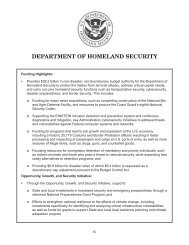A-HRC-13-42
You also want an ePaper? Increase the reach of your titles
YUMPU automatically turns print PDFs into web optimized ePapers that Google loves.
A/<strong>HRC</strong>/<strong>13</strong>/<strong>42</strong><br />
page 28<br />
prohibition of enforced disappearance is a rule of customary international humanitarian law<br />
applicable in all situations of armed conflict. 64<br />
56. As incommunicado detention is also prohibited under international humanitarian law<br />
applicable to all armed conflicts 65 and to all persons who no longer take direct part in<br />
hostilities, 66 detainees must be registered, provided an effective opportunity to immediately<br />
inform their family and a centralized information bureau of their detention and any subsequent<br />
transfer, and must be permitted ongoing contact with family members and others outside the<br />
place of detention. 67 Article 5 of the Fourth Geneva Convention permits the detaining power to<br />
deny to persons these rights and privileges “where absolute military security so requires” when<br />
an individual found physically in the State’s own territory is “definitely suspected of or engaged<br />
in activities hostile to the security of the State”, or when an individual in occupied territory is<br />
“detained as a spy or saboteur, or as a person under definite suspicion of activity hostile to the<br />
security of the Occupying Power”. While the article states that these persons “shall also be<br />
granted the full rights and privileges of a protected person under the present Convention at the<br />
earliest date consistent with the security of the State or Occupying Power”, ICRC stresses that<br />
article 5 may only be applied in individual cases of an exceptional nature, when the existence of<br />
specific charges makes it almost certain that penal proceedings will follow. Bare suspicion of<br />
hostile activities would not suffice; it would have to be a definite suspicion of such<br />
activities. The burden of definite suspicion is a high burden that must be individualized and must<br />
not be of a general nature. 68<br />
III. SECRET DETENTION PRACTICES IN PAST CONTEXTS<br />
A. The emergence of the recent practice of secret detention<br />
57. The phenomenon of secret detention, closely intertwined with enforced disappearances,<br />
can be traced at least to the Nacht und Nebel Erlaß of the Nazi Germany, the “night and fog<br />
decree”, according to which suspected resistance movement members could be arrested in<br />
occupied Europe and secretly transferred to Germany “under cover of night”. 69 These measures<br />
64 Henckaerts and Doswald-Beck, op.cit., pp. 340-343.<br />
65 Ibid., pp. 344-352.<br />
66 Ibid., p. 299.<br />
67 Third Geneva Convention, art. 48, 70 and 122; and Fourth Geneva Convention, art. 25, 26,<br />
41, 78, 79, 106, 107, 116, 128 and <strong>13</strong>6.<br />
68 Commentary to Convention (IV) Relative to the Protection of Civilian Persons in Time of<br />
War, Geneva, 12 August 1949, art. 5, available at www.icrc.org.<br />
69 Christopher K. Hall, “Enforced disappearance of persons”, in Otto Triffterer (ed.),<br />
Commentary on the Rome Statute of the International Criminal Court, Baden-Baden 1999,<br />
p. 151, with further related references.
















